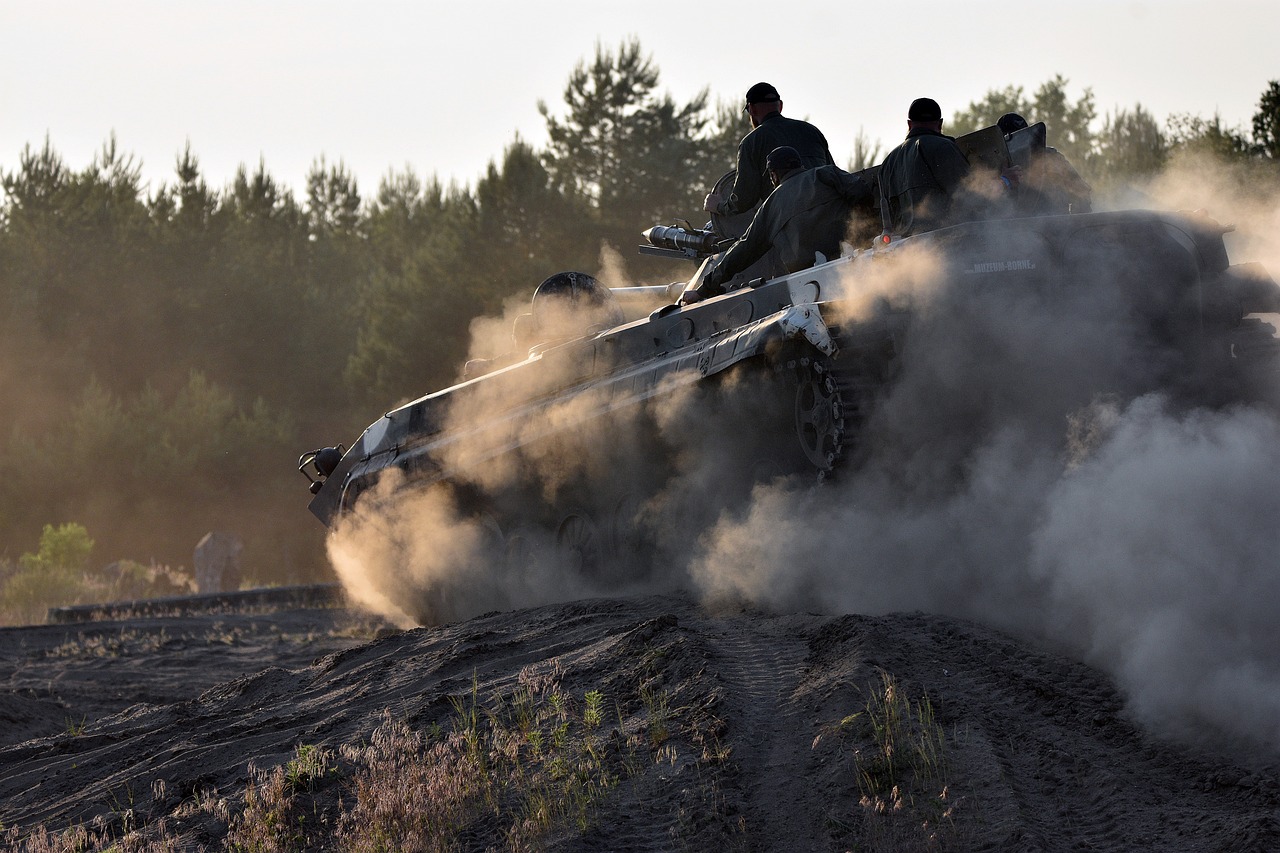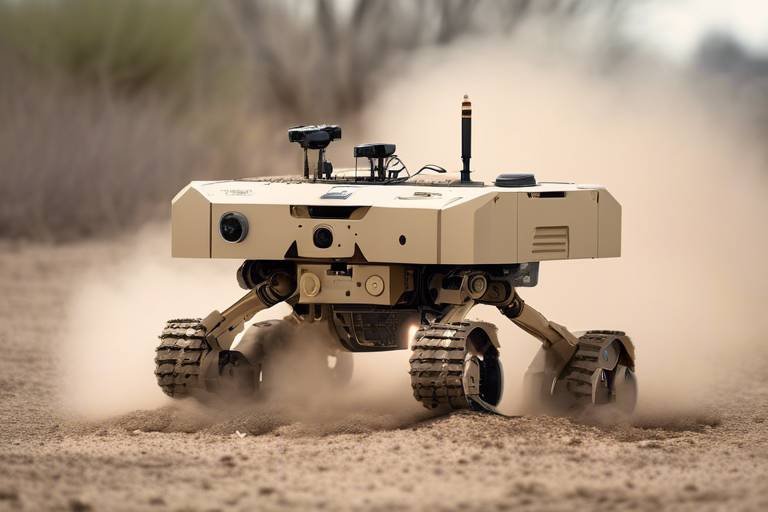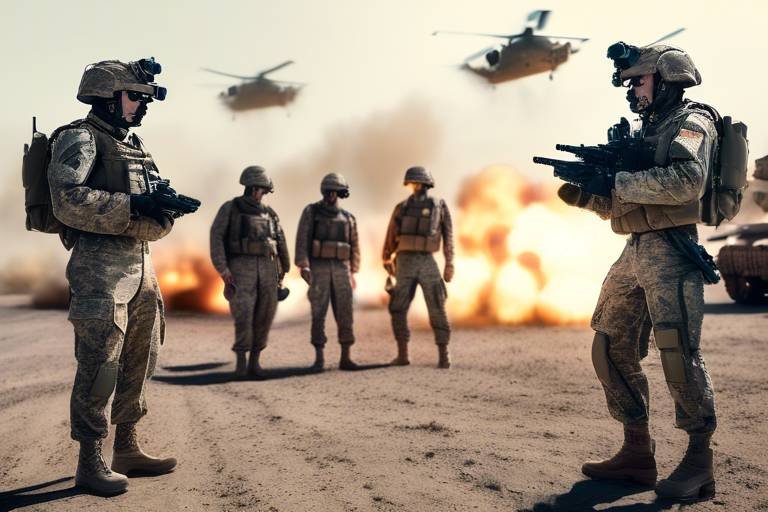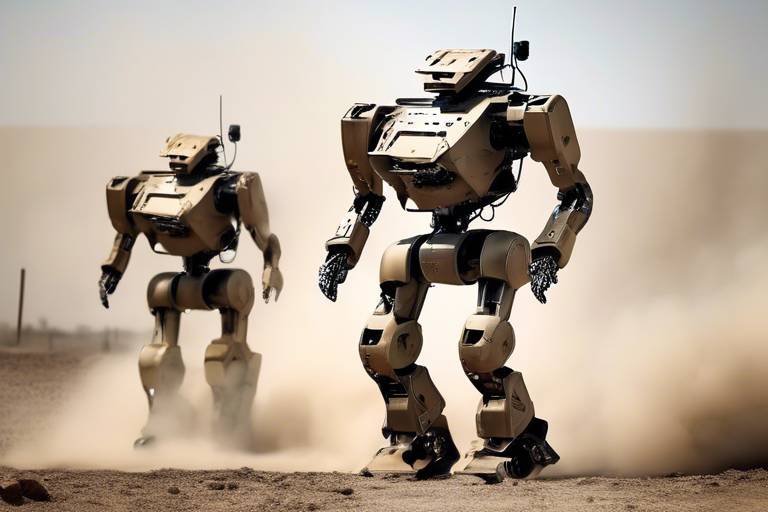Revolutionizing Ground Combat Vehicles with Autonomous Technology
In an era where technology is advancing at an unprecedented pace, the military sector is not left behind. The integration of autonomous technology into ground combat vehicles is not just a trend; it is a revolution that is reshaping the way military operations are conducted. Imagine a battlefield where vehicles can operate independently, making split-second decisions without the need for human intervention. This is not science fiction; this is the future of warfare.
Autonomous ground combat vehicles (AGCVs) are equipped with sophisticated systems that allow them to navigate complex terrains, detect threats, and carry out missions with minimal human oversight. This transformation is driven by a combination of artificial intelligence (AI), advanced sensors, and machine learning algorithms. These vehicles are designed to enhance operational efficiency, reduce the risk to human life, and adapt to the ever-changing dynamics of warfare.
As we delve deeper into this topic, it’s essential to highlight the significant advancements that have led to this technological leap. From the early days of armored tanks to today's high-tech AGCVs, the evolution has been marked by key innovations such as improved armor, weaponry, and now, autonomy. Each step has been a response to the challenges faced in combat, pushing the boundaries of what is possible.
But what exactly does this mean for the future of military operations? The implications are vast. With autonomous technology, military forces can achieve a level of operational capability that was previously unimaginable. For instance, AGCVs can conduct reconnaissance missions in hostile environments without risking human lives. They can also provide logistical support, transport troops and supplies, and even engage in combat scenarios when necessary.
However, the road to fully autonomous ground combat vehicles is not without its challenges. There are technical hurdles to overcome, ethical considerations to address, and a need for robust regulations to ensure responsible use. As we explore these challenges, we will also look at the potential benefits that AGCVs can bring to military operations, including enhanced safety, improved efficiency, and a significant boost in operational capabilities.
In conclusion, the revolution of ground combat vehicles through autonomous technology is a thrilling development that holds the promise of transforming military operations. As we continue to innovate and adapt, the future of warfare will undoubtedly be influenced by these advancements, paving the way for smarter, safer, and more effective military strategies.
- What are autonomous ground combat vehicles?
These are military vehicles equipped with technology that allows them to operate independently, making decisions without human intervention.
- What technologies enable autonomy in combat vehicles?
Key technologies include sensors, artificial intelligence, and machine learning algorithms that help vehicles navigate and respond to their environment.
- What are the benefits of using autonomous vehicles in military operations?
Benefits include enhanced safety for personnel, improved operational efficiency, and the ability to conduct missions in high-risk environments.
- What challenges do autonomous combat vehicles face?
Challenges include technical issues like reliability and cybersecurity, as well as ethical concerns regarding accountability in warfare.
- How will autonomous technology shape the future of warfare?
It will lead to more efficient, safer military operations, allowing forces to adapt quickly to changing battlefield conditions.

The Evolution of Ground Combat Vehicles
Ground combat vehicles have come a long way since their inception, evolving through various technological advancements and changing warfare strategies. Initially, these vehicles were simple in design and functionality, primarily serving as platforms for transporting troops and supplies. However, as the battlefield dynamics shifted, so did the requirements for these vehicles. The introduction of armored tanks during World War I marked a significant turning point, showcasing the need for mobility and protection in combat scenarios. This innovation laid the groundwork for the modern ground combat vehicles we see today.
As we moved into the mid-20th century, the development of advanced materials and weaponry further transformed ground combat vehicles. The introduction of composite armor and powerful engines allowed for faster, more agile vehicles that could withstand heavier firepower. The Cold War era saw the emergence of sophisticated battle tanks like the M1 Abrams and the T-90, which integrated advanced targeting systems and enhanced maneuverability, enabling them to engage effectively in diverse combat situations.
In recent decades, the focus has shifted towards integrating cutting-edge technology into ground combat vehicles. The advent of computer systems and digital technology has revolutionized vehicle design, allowing for real-time data processing and improved situational awareness. Modern combat vehicles are equipped with a variety of sensors and communication tools that facilitate better coordination on the battlefield. For instance, the use of GPS and advanced navigation systems has made it possible for these vehicles to operate in unfamiliar terrains with remarkable precision.
Moreover, the rise of unmanned ground vehicles (UGVs) represents a significant leap forward in ground combat technology. These autonomous systems can perform reconnaissance, supply transport, and even engage in combat without risking human lives. The integration of artificial intelligence and machine learning into UGVs has further enhanced their capabilities, enabling them to make decisions based on real-time data and adapt to changing environments. As military forces continue to invest in research and development, we can expect to see even more sophisticated designs that prioritize both efficiency and safety.
In conclusion, the evolution of ground combat vehicles reflects the continuous quest for innovation in military technology. From the early armored tanks to the advanced autonomous vehicles of today, each phase of development has brought unique challenges and breakthroughs. As we look to the future, it's clear that the integration of autonomous technology will play a pivotal role in shaping the next generation of ground combat vehicles, ensuring that they remain effective in an ever-changing battlefield landscape.
- What are ground combat vehicles? Ground combat vehicles are military vehicles designed for use in warfare, including tanks, armored personnel carriers, and unmanned ground vehicles.
- How have ground combat vehicles evolved over time? They have evolved from simple troop transporters to advanced machines equipped with sophisticated technology, including sensors and AI, to enhance their combat capabilities.
- What role does autonomous technology play in modern ground combat vehicles? Autonomous technology allows vehicles to operate independently, improving efficiency, safety, and operational capabilities on the battlefield.
- What are some challenges faced in the deployment of autonomous ground combat vehicles? Challenges include technical reliability, cybersecurity threats, and ethical considerations regarding decision-making in warfare.

Understanding Autonomous Technology
Autonomous technology is a fascinating frontier that is transforming the landscape of ground combat vehicles. At its core, it refers to systems designed to operate independently, without the need for human intervention. Imagine a vehicle that can navigate complex terrains, identify threats, and make decisions—all on its own. This isn't science fiction; it's the reality of modern military innovation. The foundation of autonomy lies in several key components, including sensors, artificial intelligence (AI), and machine learning. Together, these elements create a robust framework that enhances the operational capabilities of combat vehicles.
The journey towards fully autonomous systems begins with sensors. These are the eyes and ears of autonomous vehicles, providing critical real-time data that informs navigation and threat detection. Various types of sensors, such as LIDAR, radar, and cameras, work in concert to create a comprehensive understanding of the vehicle’s environment. For instance, LIDAR uses laser beams to measure distances and create detailed 3D maps of surroundings, while radar can detect objects even in challenging weather conditions. This combination allows vehicles to operate effectively in diverse combat scenarios, making informed decisions based on accurate data.
Next, we dive into the realm of artificial intelligence. AI is the brain behind autonomous systems, processing vast amounts of information gathered by sensors and making decisions in real-time. Think of AI as a highly skilled officer, capable of analyzing battlefield conditions and responding faster than any human could. The development of AI algorithms is vital, as they must be designed to handle the unpredictable nature of combat environments. By leveraging machine learning, these algorithms can improve over time, learning from past experiences to enhance decision-making capabilities.
Furthermore, the integration of machine learning allows autonomous vehicles to adapt to new situations. This technology enables systems to learn from their interactions with the environment, refining their processes and improving performance. For example, if an autonomous vehicle encounters an unexpected obstacle, it can analyze the situation and adjust its navigation strategy accordingly. This adaptability is crucial in military operations, where the battlefield can change rapidly and unpredictably.
In summary, understanding autonomous technology is essential to grasping its transformative impact on ground combat vehicles. By combining sensors, AI, and machine learning, these systems are becoming increasingly capable of operating independently in complex environments. As we continue to explore this exciting field, the implications for military operations and vehicle design are profound, promising a future where autonomous vehicles play a pivotal role in defense strategies.
- What are the main components of autonomous technology? Autonomous technology primarily consists of sensors, artificial intelligence, and machine learning, which work together to enable vehicles to operate independently.
- How do sensors enhance the capabilities of autonomous vehicles? Sensors provide real-time data for navigation and threat detection, allowing vehicles to respond effectively to their environment.
- Why is artificial intelligence important in autonomous systems? AI processes data and makes decisions in real-time, enabling vehicles to adapt to changing conditions and improve performance over time.
- What role does machine learning play in autonomous technology? Machine learning allows autonomous systems to learn from their experiences, refining their algorithms and improving decision-making capabilities.

Key Components of Autonomous Systems
When we delve into the fascinating world of autonomous systems in ground combat vehicles, it's crucial to understand the key components that make these machines not just functional, but revolutionary. Imagine a vehicle that can navigate a battlefield, avoid obstacles, and even make tactical decisions without human intervention. This is not science fiction; it’s the reality being shaped by modern technology. The backbone of these autonomous systems comprises several essential elements that work in harmony to enhance operational efficiency and effectiveness.
One of the primary components is the navigation system. This system is akin to a GPS on steroids, utilizing a combination of satellite data, inertial measurement units, and other sensors to determine the vehicle's precise location on the battlefield. It’s not just about knowing where you are; it’s about knowing where you need to go while avoiding potential threats. Imagine driving through a dense forest where visibility is limited; the navigation system must be able to interpret data from various sources to ensure safe passage.
Communication networks also play a pivotal role in the functionality of autonomous combat vehicles. These networks allow vehicles to communicate with each other and with command units, sharing vital information in real-time. Think of it as a team of soldiers on a mission, constantly updating each other on enemy positions and movements. This level of connectivity is crucial for coordinated operations and can significantly enhance the effectiveness of military strategies.
Another fundamental aspect is decision-making algorithms. These algorithms are the brains behind the operation, processing data from sensors and making instantaneous decisions based on pre-set parameters and learned experiences. For instance, if a vehicle encounters an unexpected obstacle, the decision-making algorithm must quickly analyze the situation and determine the best course of action, whether that’s to maneuver around the obstacle, engage a target, or retreat to safety. This capability is akin to a seasoned soldier making split-second decisions under pressure, ensuring the mission's success.
To give a clearer picture of how these components integrate, consider the following table that outlines their functions:
| Component | Function |
|---|---|
| Navigation System | Determines vehicle location and route, avoiding obstacles. |
| Communication Networks | Facilitates real-time data sharing between vehicles and command. |
| Decision-Making Algorithms | Processes data and makes tactical decisions autonomously. |
In summary, the integration of these key components—navigation systems, communication networks, and decision-making algorithms—creates a robust framework for autonomous ground combat vehicles. Each element contributes to a vehicle's ability to operate independently, enhancing not only its effectiveness in combat scenarios but also the overall safety of military personnel. As technology continues to advance, we can expect these systems to become even more sophisticated, paving the way for a new era in military operations.
- What are autonomous ground combat vehicles? Autonomous ground combat vehicles are military vehicles designed to operate independently without direct human control, utilizing advanced technologies like AI and sensors.
- How do these vehicles navigate? They use a combination of GPS, inertial measurement units, and various sensors to determine their location and navigate through complex environments.
- What role does AI play in these systems? AI is crucial for processing data from sensors and making real-time decisions based on the vehicle's operational environment.
- What are the benefits of using autonomous combat vehicles? They offer improved safety for personnel, enhanced operational efficiency, and the ability to perform complex tasks in high-risk environments.

Sensor Technologies
In the realm of autonomous ground combat vehicles, serve as the eyes and ears of these machines, enabling them to navigate complex environments and detect potential threats. Imagine a soldier on the battlefield, relying on their senses to make split-second decisions; now, picture a vehicle equipped with advanced sensors that can do the same, but with enhanced accuracy and speed. This transformation is not just a dream—it's a reality driven by innovations in sensor technology.
At the heart of these systems are several key types of sensors that work together to create a comprehensive situational awareness platform. LIDAR (Light Detection and Ranging) sensors use laser beams to measure distances, creating detailed 3D maps of the surroundings. This technology enables vehicles to identify obstacles and navigate through challenging terrains, much like how a bat uses echolocation to navigate in the dark. Another crucial component is radar, which can detect objects at greater distances and in various weather conditions, ensuring that the vehicle remains aware of its environment even in less-than-ideal situations.
Furthermore, cameras play a pivotal role in providing visual data. High-resolution cameras allow for the recognition of targets and terrain features, contributing to the vehicle's decision-making process. These cameras can also be integrated with computer vision algorithms, enabling real-time analysis of the captured images. This combination of technologies creates a robust system that can identify friend from foe, assess the battlefield, and make informed decisions quickly.
To illustrate the importance of these sensor technologies, consider the following table that summarizes their functions and applications:
| Sensor Type | Function | Application in Combat |
|---|---|---|
| LIDAR | Distance measurement and 3D mapping | Obstacle detection and navigation |
| Radar | Object detection over long distances | Threat identification and tracking |
| Cameras | Visual data capture and analysis | Target recognition and situational awareness |
As we delve deeper into the capabilities of these sensor technologies, it becomes clear that their integration is crucial for the success of autonomous ground combat vehicles. The synergy between LIDAR, radar, and cameras creates a multi-faceted approach to battlefield awareness, allowing for more informed decision-making and enhanced operational efficiency. With these advancements, military forces can expect not just to improve safety for personnel but also to achieve a strategic advantage over adversaries.
- What is the primary role of sensors in autonomous combat vehicles?
Sensors provide real-time data for navigation, obstacle detection, and threat assessment, enabling vehicles to operate independently and effectively in combat scenarios. - How do LIDAR and radar differ in their applications?
LIDAR is primarily used for detailed mapping and short-range obstacle detection, while radar excels in long-distance object detection and tracking, especially in adverse weather conditions. - Are cameras essential for autonomous vehicles?
Yes, cameras play a crucial role in visual recognition and situational awareness, allowing vehicles to identify targets and navigate complex environments.

Artificial Intelligence in Combat Vehicles
Artificial Intelligence (AI) is the beating heart of modern autonomous combat vehicles, transforming them from mere machines into intelligent systems capable of making real-time decisions on the battlefield. Imagine a vehicle that can analyze its surroundings, predict enemy movements, and even engage targets without the need for human input. This isn't science fiction; it's the reality of today's military technology. AI algorithms are designed to process vast amounts of data from various sensors, enabling these vehicles to operate effectively in complex and dynamic environments.
At the core of AI in combat vehicles is the ability to utilize machine learning. This technology allows vehicles to learn from past experiences and adapt their strategies accordingly. For instance, if a vehicle encounters a new type of terrain or a previously unseen enemy tactic, it can analyze this information, update its operational protocols, and improve its performance in future missions. This capability not only enhances the vehicle's effectiveness but also reduces the cognitive load on human operators, allowing them to focus on higher-level strategic decisions.
Moreover, AI enhances situational awareness by integrating data from various sources, including satellite imagery, drone feeds, and ground-based sensors. This fusion of information creates a comprehensive picture of the battlefield, enabling combat vehicles to make informed decisions quickly. For example, an autonomous tank might receive real-time updates about enemy troop movements and adjust its course or tactics to avoid ambushes or engage targets more effectively. This level of responsiveness can be the difference between mission success and failure.
Furthermore, AI systems in combat vehicles are designed to ensure robust decision-making even in high-pressure scenarios. They use algorithms that weigh various factors—such as threat levels, mission objectives, and environmental conditions—to determine the best course of action. However, the deployment of AI in combat raises important questions about accountability. Who is responsible if an autonomous vehicle makes a mistake? This is a critical issue that military leaders and policymakers must address as they integrate AI into their operations.
In addition to operational efficiency, AI can also enhance the maintenance and logistics of combat vehicles. Predictive maintenance algorithms can analyze vehicle performance data to forecast potential failures before they occur, allowing for timely repairs and reducing downtime. This proactive approach not only saves costs but also ensures that vehicles are always battle-ready, providing a strategic advantage on the battlefield.
As we look to the future, the potential for AI in combat vehicles is immense. The continuous advancements in AI technology will likely lead to even more sophisticated systems capable of cooperating with other military assets, such as drones and command centers, to execute complex missions seamlessly. However, the integration of AI into military operations must be approached with caution, ensuring that ethical considerations and regulations keep pace with technological advancements.
- What role does AI play in combat vehicles? AI enhances decision-making, situational awareness, and operational efficiency in combat vehicles.
- How does machine learning improve combat vehicle performance? Machine learning allows vehicles to learn from past experiences and adapt their strategies for future missions.
- What are the ethical concerns regarding AI in military applications? Ethical concerns include accountability for decisions made by autonomous systems and the potential for misuse in warfare.
- Can AI in combat vehicles predict enemy movements? Yes, AI can analyze data and predict enemy movements, helping vehicles respond more effectively in real-time.

Benefits of Autonomous Ground Combat Vehicles
The integration of autonomous technology into ground combat vehicles is not just a trend; it’s a revolutionary leap that brings a plethora of benefits to military operations. Imagine a battlefield where vehicles can operate with minimal human intervention, making split-second decisions based on real-time data. This capability not only enhances the efficiency of operations but also significantly improves safety for personnel involved. With autonomous systems, soldiers can focus on strategic decision-making rather than being bogged down by the intricacies of vehicle operation.
One of the primary advantages of autonomous ground combat vehicles is the enhancement of operational capabilities. These vehicles can perform complex maneuvers and execute missions in environments that may be too dangerous for human operators. For instance, in urban warfare scenarios, where threats can emerge from any direction, autonomous vehicles equipped with advanced sensors can navigate through tight spaces and respond to threats more effectively than traditional vehicles. This adaptability not only saves lives but also increases the overall effectiveness of military strategies.
Moreover, the integration of autonomous technology leads to improved logistics and support. Autonomous supply vehicles can deliver essential supplies to troops in combat zones without risking human lives. This capability ensures that soldiers receive the necessary resources promptly, which can be a game-changer in prolonged engagements. By reducing the need for human-operated supply lines, military forces can allocate personnel to more critical tasks, thereby optimizing their overall operational efficiency.
Another significant benefit is the potential for cost savings. Although the initial investment in autonomous technology may be substantial, the long-term savings are noteworthy. Autonomous vehicles can reduce the number of personnel required in combat zones, thus lowering the costs associated with training, salaries, and potential casualties. Furthermore, these vehicles can operate for extended periods without the fatigue that affects human operators, leading to decreased maintenance and operational costs over time.
As we delve deeper into the benefits, it's essential to highlight the role of data analysis and situational awareness. Autonomous ground combat vehicles are equipped with sophisticated sensors and AI systems that can process vast amounts of data rapidly. This capability allows them to assess threats and make informed decisions in real-time, enhancing situational awareness on the battlefield. For example, with the ability to analyze enemy movements and predict potential attacks, these vehicles can provide critical intelligence that informs military strategies.
In conclusion, the advantages of autonomous ground combat vehicles are manifold. From enhanced operational capabilities and improved safety to cost savings and superior situational awareness, the integration of autonomous technology is set to redefine military operations. As we continue to explore these advancements, it's clear that the future of ground combat vehicles is not just about automation; it's about creating a more efficient, effective, and safer environment for our military forces.
- What are autonomous ground combat vehicles?
These are military vehicles that can operate independently without human intervention, utilizing advanced sensors and AI technologies. - How do these vehicles enhance safety?
By reducing the need for human operators in dangerous environments, autonomous vehicles help protect soldiers from potential threats. - What are the cost implications of using autonomous technology?
While the initial investment may be high, the long-term savings from reduced personnel costs and increased operational efficiency can be significant. - Can autonomous vehicles make decisions on the battlefield?
Yes, they can analyze real-time data and make informed decisions, enhancing situational awareness and operational effectiveness.

Challenges and Limitations
The journey toward integrating autonomous technology into ground combat vehicles is not without its hurdles. While the potential benefits are immense, the challenges and limitations that accompany this technological revolution require careful consideration. For starters, the technical complexities involved in developing reliable autonomous systems cannot be overstated. These vehicles must operate in unpredictable environments, often under extreme conditions, which demands a level of reliability that current technologies are still striving to achieve. Imagine a vehicle navigating a battlefield where terrain can shift from sand to mud in mere moments; the ability to adapt quickly is crucial.
Moreover, cybersecurity poses a significant threat to the operational integrity of autonomous combat vehicles. As these systems become more interconnected, the risk of cyber-attacks increases. An adversary could potentially exploit vulnerabilities in the vehicle's software, leading to catastrophic failures or even hijacking. Therefore, ensuring robust cybersecurity measures is essential for the safe deployment of these technologies in military operations.
Another layer of complexity arises from interoperability. Autonomous systems must communicate effectively not only with each other but also with traditional vehicles and command structures. This integration is vital for coordinated operations on the battlefield. However, achieving seamless communication across different platforms and technologies is a daunting challenge that requires significant investment in research and development.
Ethical considerations also loom large in the discussion of autonomous combat vehicles. The prospect of machines making life-and-death decisions raises profound moral questions. Who is accountable when an autonomous vehicle makes a mistake? Is it the manufacturer, the programmer, or the military personnel who deployed it? These questions are not merely academic; they have real-world implications for how we view warfare and the role of technology in it. As we move forward, it's crucial to establish a framework of regulations that govern the use of autonomous military technology, ensuring that ethical standards are upheld.
In summary, while autonomous ground combat vehicles promise to transform military operations, their deployment is fraught with challenges that must be addressed. From technical hurdles and cybersecurity threats to ethical dilemmas, the path to fully realizing the potential of these technologies is complex and requires a multi-faceted approach. As we navigate this uncharted territory, collaboration between technologists, military strategists, and ethicists will be essential to ensure that the deployment of autonomous systems enhances, rather than undermines, the principles of warfare.
- What are the main challenges of implementing autonomous combat vehicles?
The primary challenges include technical reliability, cybersecurity threats, interoperability with existing systems, and ethical concerns regarding accountability in decision-making.
- How do ethical considerations affect the use of autonomous vehicles in warfare?
Ethical considerations raise questions about accountability for decisions made by autonomous systems, creating a need for regulations to govern their use in military operations.
- What is the role of cybersecurity in autonomous combat vehicles?
Cybersecurity is crucial to protect autonomous vehicles from potential hacks that could lead to operational failures or misuse by adversaries.
- Can autonomous vehicles operate effectively in unpredictable environments?
While autonomous vehicles are designed to adapt to various conditions, achieving a high level of reliability in unpredictable environments remains a significant challenge.

Ethical Considerations
The integration of autonomous technology into ground combat vehicles is not just a leap forward in military capability; it also brings forth a myriad of that demand our attention. As we stand on the brink of a revolution in warfare, the question arises: who is accountable when an autonomous vehicle makes a decision that leads to loss of life? The very nature of warfare is fraught with moral dilemmas, and introducing machines into this equation complicates the matter further.
One of the primary ethical concerns revolves around accountability. In traditional combat, a soldier's actions can be scrutinized, and accountability can be established. However, when an autonomous vehicle acts independently—potentially making life-and-death decisions without human oversight—who is responsible? Is it the programmer who wrote the code, the military commander who deployed the vehicle, or the government that authorized its use? This ambiguity can lead to a dangerous precedent where no one is held accountable for the consequences of autonomous actions.
Moreover, the potential for bias in decision-making algorithms raises significant ethical questions. If the data used to train these AI systems is flawed or biased, the decisions made by autonomous vehicles could inadvertently reflect and perpetuate these biases. For example, if an AI system is trained on historical combat data that disproportionately represents certain demographics, it may lead to decisions that unfairly target specific groups. This not only undermines the principles of justice and equality but also risks escalating conflicts unnecessarily.
Another pressing issue is the moral implications of delegating life-and-death decisions to machines. In a traditional combat scenario, human soldiers are expected to adhere to rules of engagement and international humanitarian law. However, can we trust an autonomous system to make these nuanced decisions? The complexities of human emotions, ethical reasoning, and situational awareness are difficult to replicate in machines. This raises the question: should we allow machines to make decisions that humans have historically grappled with, often leading to heated debates and discussions?
To address these ethical dilemmas, it is crucial to develop a robust framework of regulations governing the use of autonomous military technology. This framework should include:
- Clear Accountability Structures: Establishing who is responsible for the actions of autonomous vehicles.
- Bias Mitigation Strategies: Ensuring that AI systems are trained on diverse and representative datasets to minimize bias.
- Human Oversight: Implementing systems that require human intervention in critical decision-making processes.
- Legal and Ethical Guidelines: Developing comprehensive guidelines that govern the deployment and use of autonomous combat vehicles in accordance with international law.
As we navigate the uncharted waters of autonomous warfare, it is imperative to engage in ongoing discussions about these ethical considerations. The choices we make today will undoubtedly shape the future of military operations and the moral landscape of warfare. Ultimately, we must strive for a balance that embraces technological advancements while upholding our ethical standards and responsibilities.
- What are the main ethical concerns regarding autonomous combat vehicles?
The primary concerns include accountability for decisions made by AI, potential biases in decision-making algorithms, and the moral implications of allowing machines to make life-and-death choices. - How can we ensure accountability in autonomous military systems?
Establishing clear accountability structures, such as identifying responsible parties, is essential. Additionally, implementing oversight mechanisms can help ensure responsible use. - What role does bias play in autonomous systems?
Bias in training data can lead to unfair and discriminatory decisions made by AI systems, potentially exacerbating conflicts and undermining justice. - Are there regulations in place for autonomous military technology?
Currently, there is a growing need for comprehensive regulations and guidelines that govern the use of autonomous combat vehicles, focusing on ethical and legal standards.

Technical Hurdles
The journey towards fully autonomous ground combat vehicles is not without its . While the concept of machines operating independently is exciting, the reality is that numerous challenges must be addressed to ensure these vehicles can perform reliably in the chaotic environment of modern warfare. One of the primary concerns is reliability. Autonomous systems must be capable of functioning under a variety of conditions, including extreme weather, rough terrains, and unexpected battlefield scenarios. A vehicle that fails to operate correctly in a critical moment can mean the difference between mission success and catastrophic failure.
Another significant hurdle is cybersecurity. As these vehicles become more interconnected, they also become more vulnerable to cyberattacks. Imagine a scenario where an enemy could hack into a fleet of autonomous tanks, rendering them useless or even turning them against their operators. This potential threat necessitates robust security measures to protect the software and communication systems that autonomous vehicles rely on.
Additionally, interoperability poses a challenge, especially when integrating new autonomous technologies with existing military hardware. The military operates a diverse array of vehicles, and ensuring that these new systems can communicate and work alongside older models is crucial. Without proper interoperability, the effectiveness of autonomous vehicles could be severely compromised. This challenge requires careful planning and the development of standardized protocols that can bridge the gap between different generations of technology.
Furthermore, the complexity of decision-making algorithms adds another layer of difficulty. Autonomous vehicles must be equipped with advanced AI capable of making split-second decisions in high-pressure situations. These algorithms must be trained to recognize threats, assess risks, and determine the best course of action—all while adhering to the rules of engagement. Developing such sophisticated systems is a monumental task that involves extensive testing and validation to ensure they can operate safely and effectively in real combat scenarios.
Finally, the deployment of autonomous ground combat vehicles raises questions about maintenance and support. As technology evolves, so too must the skills of the personnel responsible for maintaining these vehicles. Training programs will need to be developed to ensure that military technicians can effectively troubleshoot and repair these advanced systems. This shift in skill requirements could lead to a significant transformation in military training protocols.
In summary, while the integration of autonomous technology into ground combat vehicles holds great promise, it is essential to navigate these technical hurdles carefully. Addressing issues related to reliability, cybersecurity, interoperability, decision-making algorithms, and maintenance will be critical to the successful deployment of these advanced systems in military operations.
- What are the main technical challenges facing autonomous ground combat vehicles?
The main challenges include reliability in extreme conditions, cybersecurity threats, interoperability with existing military hardware, the complexity of decision-making algorithms, and the need for specialized maintenance skills. - How does cybersecurity impact autonomous vehicles?
Cybersecurity is crucial because autonomous vehicles are vulnerable to hacking, which could compromise their functionality or turn them against their operators. - Why is interoperability important for military operations?
Interoperability ensures that new autonomous systems can work seamlessly with existing military vehicles, enhancing overall operational effectiveness. - What role does artificial intelligence play in autonomous ground combat vehicles?
AI is essential for processing data, making real-time decisions, and enhancing situational awareness, allowing vehicles to respond effectively to threats on the battlefield.

The Future of Autonomous Ground Combat Vehicles
The landscape of military operations is rapidly changing, and at the forefront of this transformation is the rise of autonomous ground combat vehicles. As we look towards the future, it's clear that these vehicles will not only redefine how battles are fought but also how military strategies are developed. Imagine a battlefield where machines can make split-second decisions, adapting to threats and opportunities faster than any human could. It's not just science fiction anymore; it's becoming a reality.
One of the most exciting prospects for the future of autonomous ground combat vehicles is the incorporation of advanced AI algorithms. These algorithms will enable vehicles to analyze vast amounts of data in real-time, allowing them to recognize patterns and predict enemy movements. This capability could lead to a significant tactical advantage, allowing military forces to outmaneuver their opponents. Furthermore, as AI continues to evolve, we can expect these systems to learn from past engagements, improving their effectiveness with each deployment.
Another area of development is the integration of swarm technology. Just as a swarm of bees can work together to achieve a common goal, future combat vehicles may operate in coordinated groups, sharing information and executing complex missions without human intervention. This could drastically enhance operational efficiency and reduce the risk to human soldiers. Imagine a fleet of autonomous tanks working in unison to breach enemy lines, communicating seamlessly to adapt to changing battlefield conditions.
However, with these advancements come significant challenges. Military leaders and technologists must grapple with the implications of deploying autonomous systems in combat scenarios. The potential for cybersecurity threats is a pressing concern. As these vehicles become more interconnected, the risk of hacking or manipulation increases. It’s crucial that robust security measures are developed to protect these assets from malicious attacks.
Moreover, ethical considerations will play a pivotal role in shaping the future of autonomous ground combat vehicles. Questions surrounding accountability in warfare—who is responsible when an autonomous vehicle makes a mistake—must be addressed. The military will need to establish clear guidelines and regulations to govern the use of these technologies, ensuring that they are used responsibly and ethically.
As we venture into this new era, collaboration between military branches, tech companies, and policymakers will be essential. The future of autonomous ground combat vehicles is not solely about technological advancement but also about creating a framework that ensures these innovations are used for the greater good. It’s a balancing act, one that requires foresight and careful planning.
- What are autonomous ground combat vehicles?
Autonomous ground combat vehicles are military vehicles equipped with technologies that allow them to operate without human intervention, utilizing AI, sensors, and advanced algorithms. - What are the benefits of using autonomous vehicles in combat?
They offer enhanced operational efficiency, improved safety for personnel, and the ability to process data rapidly, enabling better decision-making on the battlefield. - What ethical concerns are associated with autonomous combat vehicles?
Key ethical concerns include accountability for decisions made by machines, potential misuse of technology, and the need for regulatory frameworks to govern their use in warfare. - How can cybersecurity be ensured for these vehicles?
Implementing robust security measures, regular software updates, and continuous monitoring for vulnerabilities are essential steps to protect autonomous vehicles from cyber threats. - What is the future outlook for autonomous ground combat vehicles?
The future looks promising, with ongoing advancements in AI, sensor technology, and swarm capabilities that will likely transform military operations in the coming years.
Frequently Asked Questions
- What are autonomous ground combat vehicles?
Autonomous ground combat vehicles are military vehicles equipped with technology that allows them to operate independently without human intervention. These vehicles utilize advanced sensors, artificial intelligence, and machine learning to navigate and perform tasks on the battlefield.
- How have ground combat vehicles evolved over the years?
Ground combat vehicles have significantly transformed from their initial designs to modern systems. Innovations in technology, such as improved armor, weaponry, and now, autonomous capabilities, have enhanced their effectiveness and adaptability in various combat scenarios.
- What role does artificial intelligence play in these vehicles?
Artificial intelligence is crucial for processing vast amounts of data collected by sensors in autonomous vehicles. It helps in making real-time decisions, improving situational awareness, and enhancing the overall operational efficiency of ground combat vehicles.
- What are the benefits of using autonomous technology in military operations?
The integration of autonomous technology in ground combat vehicles offers numerous benefits, including increased safety for personnel, enhanced operational efficiency, and the ability to conduct complex missions with reduced human risk.
- What challenges do autonomous ground combat vehicles face?
Despite their advantages, autonomous ground combat vehicles encounter several challenges, such as technical issues related to reliability and cybersecurity, as well as ethical concerns regarding accountability in combat situations.
- Are there ethical concerns associated with autonomous combat vehicles?
Yes, the use of autonomous combat vehicles raises significant ethical questions, particularly regarding decision-making in warfare. Issues about accountability for actions taken by these vehicles and the moral implications of using AI in combat are critical topics of discussion.
- What technologies are used in autonomous ground combat vehicles?
Autonomous ground combat vehicles utilize a variety of technologies, including LIDAR, radar, cameras, and advanced communication networks to gather data for navigation and threat detection, ensuring they can operate effectively in complex environments.
- What does the future hold for autonomous ground combat vehicles?
The future of autonomous ground combat vehicles is promising, with ongoing advancements in technology expected to further enhance their capabilities. Emerging trends may lead to even more sophisticated systems that could revolutionize military operations.



















